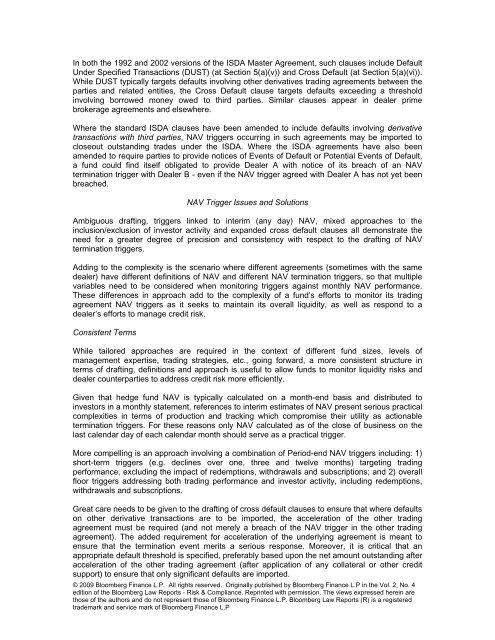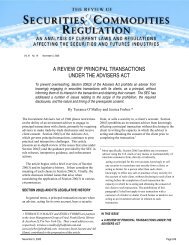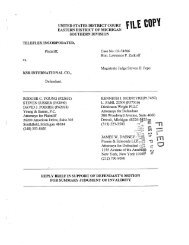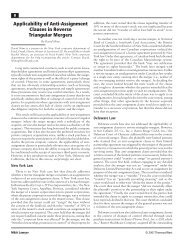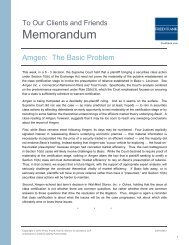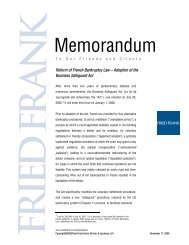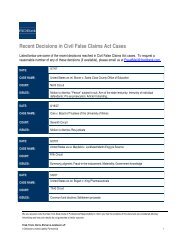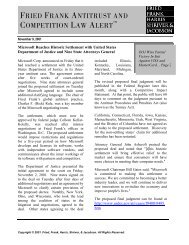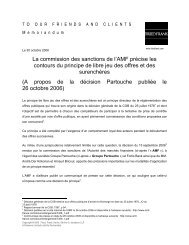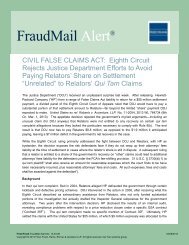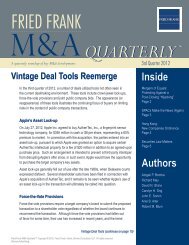Trading Agreements and NAV Termination Triggers ... - Fried Frank
Trading Agreements and NAV Termination Triggers ... - Fried Frank
Trading Agreements and NAV Termination Triggers ... - Fried Frank
You also want an ePaper? Increase the reach of your titles
YUMPU automatically turns print PDFs into web optimized ePapers that Google loves.
In both the 1992 <strong>and</strong> 2002 versions of the ISDA Master Agreement, such clauses include DefaultUnder Specified Transactions (DUST) (at Section 5(a)(v)) <strong>and</strong> Cross Default (at Section 5(a)(vi)).While DUST typically targets defaults involving other derivatives trading agreements between theparties <strong>and</strong> related entities, the Cross Default clause targets defaults exceeding a thresholdinvolving borrowed money owed to third parties. Similar clauses appear in dealer primebrokerage agreements <strong>and</strong> elsewhere.Where the st<strong>and</strong>ard ISDA clauses have been amended to include defaults involving derivativetransactions with third parties, <strong>NAV</strong> triggers occurring in such agreements may be imported tocloseout outst<strong>and</strong>ing trades under the ISDA. Where the ISDA agreements have also beenamended to require parties to provide notices of Events of Default or Potential Events of Default,a fund could find itself obligated to provide Dealer A with notice of its breach of an <strong>NAV</strong>termination trigger with Dealer B - even if the <strong>NAV</strong> trigger agreed with Dealer A has not yet beenbreached.<strong>NAV</strong> Trigger Issues <strong>and</strong> SolutionsAmbiguous drafting, triggers linked to interim (any day) <strong>NAV</strong>, mixed approaches to theinclusion/exclusion of investor activity <strong>and</strong> exp<strong>and</strong>ed cross default clauses all demonstrate theneed for a greater degree of precision <strong>and</strong> consistency with respect to the drafting of <strong>NAV</strong>termination triggers.Adding to the complexity is the scenario where different agreements (sometimes with the samedealer) have different definitions of <strong>NAV</strong> <strong>and</strong> different <strong>NAV</strong> termination triggers, so that multiplevariables need to be considered when monitoring triggers against monthly <strong>NAV</strong> performance.These differences in approach add to the complexity of a fund’s efforts to monitor its tradingagreement <strong>NAV</strong> triggers as it seeks to maintain its overall liquidity, as well as respond to adealer’s efforts to manage credit risk.Consistent TermsWhile tailored approaches are required in the context of different fund sizes, levels ofmanagement expertise, trading strategies, etc., going forward, a more consistent structure interms of drafting, definitions <strong>and</strong> approach is useful to allow funds to monitor liquidity risks <strong>and</strong>dealer counterparties to address credit risk more efficiently.Given that hedge fund <strong>NAV</strong> is typically calculated on a month-end basis <strong>and</strong> distributed toinvestors in a monthly statement, references to interim estimates of <strong>NAV</strong> present serious practicalcomplexities in terms of production <strong>and</strong> tracking which compromise their utility as actionabletermination triggers. For these reasons only <strong>NAV</strong> calculated as of the close of business on thelast calendar day of each calendar month should serve as a practical trigger.More compelling is an approach involving a combination of Period-end <strong>NAV</strong> triggers including: 1)short-term triggers (e.g. declines over one, three <strong>and</strong> twelve months) targeting tradingperformance, excluding the impact of redemptions, withdrawals <strong>and</strong> subscriptions; <strong>and</strong> 2) overallfloor triggers addressing both trading performance <strong>and</strong> investor activity, including redemptions,withdrawals <strong>and</strong> subscriptions.Great care needs to be given to the drafting of cross default clauses to ensure that where defaultson other derivative transactions are to be imported, the acceleration of the other tradingagreement must be required (<strong>and</strong> not merely a breach of the <strong>NAV</strong> trigger in the other tradingagreement). The added requirement for acceleration of the underlying agreement is meant toensure that the termination event merits a serious response. Moreover, it is critical that anappropriate default threshold is specified, preferably based upon the net amount outst<strong>and</strong>ing afteracceleration of the other trading agreement (after application of any collateral or other creditsupport) to ensure that only significant defaults are imported.© 2009 Bloomberg Finance L.P. All rights reserved. Originally published by Bloomberg Finance L.P in the Vol. 2, No. 4edition of the Bloomberg Law Reports - Risk & Compliance. Reprinted with permission. The views expressed herein arethose of the authors <strong>and</strong> do not represent those of Bloomberg Finance L.P. Bloomberg Law Reports (R) is a registeredtrademark <strong>and</strong> service mark of Bloomberg Finance L.P


